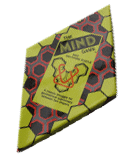|
|
 |
|
| THE MIND GAME |
 History
HistoryThe first version of Tantrix was called "The Mind Game", named after the game shops owned by the inventor, Mike McManaway. It was created in 1988 and used 56 cardboard pieces with a yellow background and lines of only two colours - red and black. The strange hexagonal playing board folded three ways into a diamond shape, which determined the shape of the box. A couple of thousand sets were silk screened in Chile and shipped back to New Zealand to test out sales in the inventor's shop. The set sold well enough to publish a second edition the following year. This time an offset printing process was used, along with a number of minor improvements. Having his own game shops, Mike was able to "test the market" and get immediate feedback from customers to decide if design changes were improvements. An experiment with the first plastic version of the Mind Game followed a year later. | ||
|
Rules The Objective: The Mind Game consists of 56 hexagonal tiles and a hexagonal playing board. Each tile has three red or black links, each of which may be connected to other links of the same colour to form continuous lines. Each player attempts to form the longest possible line by skillfully connecting up links of their own colour, while also trying to block the growth of their opponent's line. The Play:
Priority Moves:
The Winner: The game ends when all the tiles have been placed on the board or both players agree that neither can increase their longest line. The player whose longest line has the greatest number of links is the winner. |
| Home | Site Map | Products | Play Online | Buy Tantrix | About Us | Contact Us |
© Copyright 2020, Colour of Strategy Ltd, Pohara, New Zealand. All rights reserved. Last update: November, 2020 |